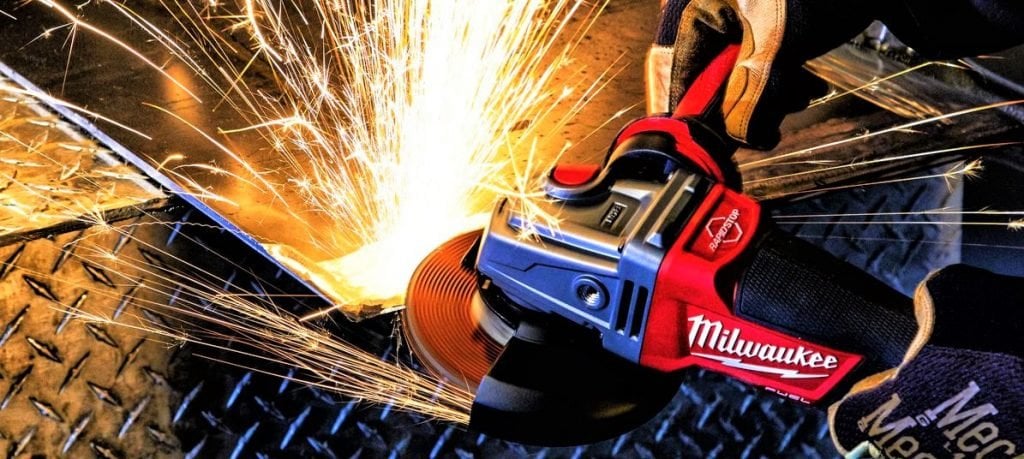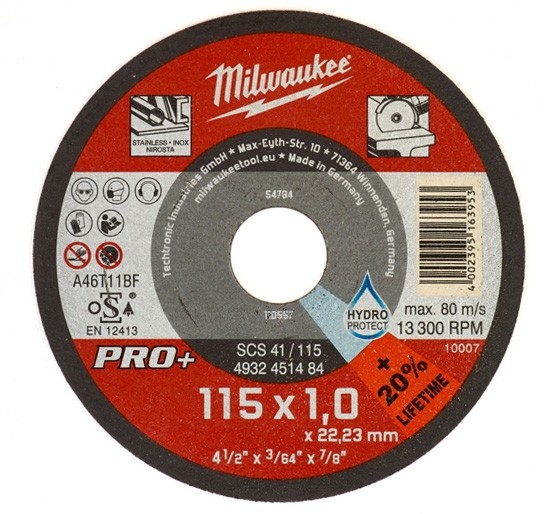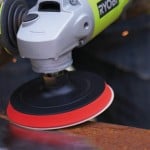Angle grinders, also known as side grinders or disc cutters, are handheld power tools used for grinding, cutting, cleaning and polishing materials. With the huge variety of jobs that can be tackled with this piece of equipment, it is an essential tool to have in your arsenal.
How does an angle grinder work?
Angle grinders are available in corded, battery or air-powered models. The angle grinder works by using a small disk or wheel and spinning it at such a high rate, typically between 8000 to 11000 RPM, enabling it to cut, grind and polish. The disks can also come in a variety of different sizes.
The angle grinder's head can be replaced when worn and typically feature an adjustable guard with side handle to allow for two-handed operation. Certain angle grinders, depending on their speed range, can be used as sanders, employing a sanding disc with a backing pad or disc.
What can you do with an angle grinder?
Angle grinders can be used for an incredibly varied number of projects. The most common use of an angle grinder is removing excess material from a piece, however, there are many different types of disks that can be used for different tasks for example, such as cut-off discs, abrasive grinding discs, grinding stones, sanding discs, wire brush wheels and polishing pads. With the correct disc, there is no end to its versatility.
For example, a grinder is useful for cutting and grinding
- Iron, steel and other metals
- Metal roof cladding, corrugated iron and other steel sheeting
- Brick, stone and concrete
- Slates and building tiles
- PVC waste pipe
- Rusted bolts which can't be undone
- Rebar in concrete
- Grinding and sharpening garden tools
- Welds on steel and also cleaning of welds
Sanding and wire brush accessories are used for:
- Removing paint
- Cleaning rust from steel
- Sanding wood
Can you use an angle grinder to cut wood?
An angle grinder is designed to grind metal or with care, cut ferrous metals using an abrasive disc. They lack a base and other safety features that circular saws have and should not be used to cut wood, especially freehand. An angle grinder typically will use a smaller diameter blade than a small circular saw and won't provide the same depth of cut. Snagging the blade can result in kickback that can prove dangerous. You can, however, use an angle grinder on wood for carving, shaping and sanding.
There are many different materials that can however safely be cut with an angle grinder, you can read what they are and cut them here.
Are grinding sparks dangerous?
Typically the sparks that come off of an angle grinder are small and very light, because of this the spark is usually small enough to cool down before it hits bare skin. However, the larger hot sparks from grinding metal are much more dangerous, since they usually are larger, and possibly consist of burning metal. The “sparks” you see when you're grinding or cutting steel is essentially steel dust hot enough to glow. However, they also have very little mass.
If you're hard at work in warm weather suffering from sweaty skin, this can actually work in your favour as the sparks tend to bounce off your skin due to Leidenfrost effect. However, if they get trapped they will burn through whatever article of clothing you're wearing, it's important to make sure your clothing and shoes are all made from natural fibres. This is because artificial fibres such as fleeces melt, and if they melt they can stick to your skin and cause serious burns.
What PPE is required when using a grinder?
Personal Protective Equipment (PPE) should be worn to protect you during all home DIY and professional work, and especially when using an angle grinder.
- Safety goggles are important to protect your eyes from stray sparks. A full-face visor will also give you additional protection should the disk or blade shatter.
- Ear Muffs or earplugs will lessen the risk of hearing damage and are always important when working with power tools.
- Dust masks are required to protect against fumes and dust particles in the air caused from cutting.
- Gloves provide immediate protection from sparks, and small fragments thrown out by the disk. They also protect your hands from general wear and tear, i.e. minor cuts, scuffs and abrasion. They should, however, be tight-fitting and not "baggy", so that you can hold the tool securely.
- Steel toe cap boots are especially needed if you are working with heavy items which could drop when cut up, as they will protect your toes.
- Overalls and/or Apronsprotect clothes from sparks. Watch out for sparks falling into pockets or turn-ups, and make sure materials are made from natural fibres.
Can an angle grinder be used as a sander?
Simply put, yes. An angle grinder can be used as both a sander and a polisher if you have the right attachment/disks available. There are thousands of disc and wheel accessories on the market, but the most common ones include abrasive grinding discs, cut-off discs, grinding stones, polishing pads, sanding discs, and wire brush wheels.
We’ve put together a collection of handy How-To guides, detailing step-by-step instructions for some important DIY task. Take a look here.
What is the difference between a die grinder and angle grinder?
Generally, the tasks carried out using a die grinder are of smaller, lighter and a more precise nature than those of an angle grinder. An angle grinder is better suited for bigger, heavier tasks due to its high horsepower and strong capabilities. Especially in situations where precision and accuracy is not much of a priority. This is because angle grinders are much larger in both weight and dimensions. Because die grinders have comparatively smaller discs and attachments they, therefore, feature faster RPM making them the better choice for delicate jobs.
What are angle grinder discs made of?
Cut Off Disks
Most typical angle grinders use a 4 1/2-inch diameter abrasive grinding disk. These are made from top-quality steel with synthetic resin as a binder to allow particles to be bonded to the surface.
Diamond Blades
The core of this blade is a round metal disc used to support outer segments, it features synthetic diamonds in its outer edge to improve cutting. This is because diamond is one of the hardest materials making it incredibly effective for cutting stone, concrete, bricks etc.
Abrasive Discs
Typically these disks are Velcro-backed or have another method of attachment so that they can be fixed to a pad or base that is then attached to the grinder, converting it into a sander.
What is an arbour on an angle grinder?
The arbour is the part of an angle grinder that the grinding or cutting disk is attached to. Powered by the grinders motor, the arbour is threaded on its outboard end. Some cutting disks and wheels can simply be placed onto the arbour and fastened in place with a special threaded nut during use. Other disks are threaded themselves and they simply screw onto the threads of the spindle. The diameter of the holes in the disks and the thread size must match the arbor. It's important that you are aware of what size the angle grinder's arbour really is when selecting a disk.
Some models (such a the Milwaukee M18CAG115XPBD Angle Grinder) feature a fixtec nut, for quick and easy disc changes.
Still Need Help?
Our in house experts are always on hand for buying advice and to provide bespoke care, regardless of the application.
Call SGS on 01332 576 850 or fill out our contact form today.












